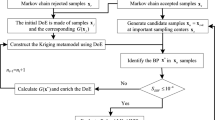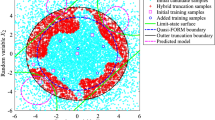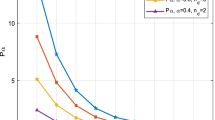Abstract
Active-learning surrogate model–based reliability analysis is widely employed in engineering structural reliability analysis to alleviate the computational burden of the Monte Carlo method. To date, most of these methods are built based on the single-fidelity surrogate model, such as the Kriging model. However, the computational burden of constructing a fine Kriging model may be still expensive if the high-fidelity (HF) simulation is extremely time-consuming. To solve this problem, an active-learning method based on the multi-fidelity (MF) Kriging model for structural reliability analysis (abbreviated as AMK-MCS+AEFF), which is an online data-driven method fusing information from different fidelities, is proposed in this paper. First, an augmented expected feasibility function (AEFF) is defined by considering the cross-correlation, the sampling density, and the cost query between HF and low-fidelity (LF) models. During the active-learning process of AMK-MCS+AEFF, both the location and fidelity level of the updated sample can be determined objectively and adaptively by maximizing the AEFF. Second, a new stopping criterion that associates with the estimated relative error is proposed to ensure that the iterative process terminates in a proper iteration. The proposed method is compared with several state-of-the-art methods through three numerical examples and an engineering case. Results show that the proposed method can provide an accurate failure probability estimation with a less computational cost.

















Similar content being viewed by others
References
Bichon BJ, Eldred MS, Swiler LP, Mahadevan S, McFarland JM (2008) Efficient global reliability analysis for nonlinear implicit performance functions. AIAA J 46:2459–2468. https://doi.org/10.2514/1.34321
Chaudhuri A, Marques AN, Willcox KE (2019) mfEGRA: multifidelity efficient global reliability analysis. arXiv:1910.02497v3
Cheng K, Lu Z (2020) Structural reliability analysis based on ensemble learning of surrogate models. Struct Saf 83:101905. https://doi.org/10.1016/j.strusafe.2019.101905
Demeyer S, Fischer N, Marquis D (2017) Surrogate model based sequential sampling estimation of conformance probability for computationally expensive systems: application to fire safety science. J Soc Fr Stat 158:111–138
Dey A, Mahadevan S (1998) Ductile structural system reliability analysis using adaptive importance sampling. Struct Saf 20:137–154. https://doi.org/10.1016/S0167-4730(97)00033-7
Du X, Hu Z (2012) First order reliability method with truncated random variables. J Mech Des 134:091005 (091009 pp.). https://doi.org/10.1115/1.4007150
Echard B, Gayton N, Lemaire M (2011) AK-MCS: an active learning reliability method combining Kriging and Monte Carlo simulation. Struct Saf 33:145–154. https://doi.org/10.1016/j.strusafe.2011.01.002
Fernandez-Godino MG, Park C, Kim NH, Haftka RT (2019) Issues in deciding whether to use multifidelity surrogates. AIAA J 57:2039–2054. https://doi.org/10.2514/1.J057750
Forrester AIJ, Sóbester A, Keane AJ (2008) Engineering design via surrogate modelling a practical guide. A John Wiley and Sons
Garud SS, Karimi IA, Kraft M (2017) Design of computer experiments: a review. Comput Chem Eng 106:71–95. https://doi.org/10.1016/j.compchemeng.2017.05.010
Gutmann HM (2001) A radial basis function method for global optimization. J Glob Optim 19:201–227. https://doi.org/10.1023/A:1011255519438
Han Z, Görtz S (2012) Hierarchical kriging model for variable-fidelity surrogate modeling. AIAA J 50:1885–1896. https://doi.org/10.2514/1.J051354
Hao P, Wang B, Li G, Meng Z, Wang L (2015) Hybrid framework for reliability-based design optimization of imperfect stiffened shells. AIAA J 53:2878–2889
Hu Z, Du X (2015) First order reliability method for time-variant problems using series expansions. Struct Multidiscip Optim 51:1–21. https://doi.org/10.1007/s00158-014-1132-9
Hu Z, Mahadevan S (2015) Global sensitivity analysis-enhanced surrogate (GSAS) modeling for reliability analysis. Struct Multidiscip Optim 53:501–521. https://doi.org/10.1007/s00158-015-1347-4
Jiang C, Qiu H, Gao L, Ca X, Li P (2017) An adaptive hybrid single-loop method for reliability-based design optimization using iterative control strategy. Struct Multidiscip Optim 56:1271–1286. https://doi.org/10.1007/s00158-017-1719-z
Jones D, Schonlau M, Welch W (1998) Efficient global optimization of expensive black-box functions. J Glob Optim 13:455–492
Keane AJ, Sóbester A, Forrester AIJ (2007) Multi-fidelity optimization via surrogate modelling. Proc Royal Soc A Math Phys Eng Sci 463:3251–3269. https://doi.org/10.1098/rspa.2007.1900
Kennedy MC, O’Hagan A (2000) Predicting the output from complex computer code when fast approximations are available. Biometrika 87:1–13
Keshtegar B, Zeng M (2017) A hybrid relaxed first-order reliability method for efficient structural reliability analysis. Struct Saf 66:84–93
Krige DG (1951) A statistical approach to some basic mine valuation problems on the witwatersrand. J Chem Metall Min Soc S Afr 52:119–139
Li C, Wang P, Dong H (2018) Kriging-based multi-fidelity optimization via information fusion with uncertainty. J Mech Sci Technol 32:245–259. https://doi.org/10.1007/s12206-017-1225-7
Lin Y, He J, Li K (2018) Hull form design optimization of twin-skeg fishing vessel for minimum resistance based on surrogate model. Adv Eng Softw 123:38–50. https://doi.org/10.1016/j.advengsoft.2018.05.010
Ling C, Lu Z, Feng K, Zhang X (2019) A coupled subset simulation and active learning kriging reliability analysis method for rare failure events. Struct Multidiscip Optim. https://doi.org/10.1007/s00158-019-02326-3
Liu H, Ong Y, Cai J, Wang Y (2018a) Cope with diverse data structures in multi-fidelity modeling: a Gaussian process method. Eng Appl Artif Intell 67:211–225. https://doi.org/10.1016/j.engappai.2017.10.008
Liu Y, Chen S, Wang F, Xiong F (2018b) Sequential optimization using multi-level cokriging and extended expected improvement criterion. Struct Multidiscip Optim 58:1155–1173. https://doi.org/10.1007/s00158-018-1959-6
Lophaven SN, Nielsen HB, Søndergaard J (2002) DACE: a Matlab kriging toolbox. Technical Report IMMTR-2002-12, Informatics and Mathematical Modelling, Technical University of Denmark
Lv Z, Lu Z, Wang P (2015) A new learning function for Kriging and its applications to solve reliability problems in engineering. Comput Math Appl 70:1182–1197. https://doi.org/10.1016/j.camwa.2015.07.004
Marques A, Lam R, Willcox K (2018) Contour location via entropy reduction leveraging multiple information sources. In: Advances in Neural Information Processing Systems, pp 5217–5227
Pradlwarter HJ, Schueller GI, Koutsourelakis PS, Charmpis DC (2007) Application of line sampling simulation method to reliability benchmark problems. Struct Saf 29:208–221. https://doi.org/10.1016/j.strusafe.2006.07.009
Qian J, Yi J, Cheng Y, Liu J, Zhou Q (2020) A sequential constraints updating approach for Kriging surrogate model-assisted engineering optimization design problem. Eng Comput 36:993–1009. https://doi.org/10.1007/s00366-019-00745-w
Rackwitz R (2001) Reliability analysis—a review and some perspectives. Struct Saf 23:365–395. https://doi.org/10.1016/S0167-4730(02)00009-7
Regis RG (2014) Particle swarm with radial basis function surrogates for expensive black-box optimization. J Comput Sci 5:12–23. https://doi.org/10.1016/j.jocs.2013.07.004
Reisenthel PH, Allen TT (2013) Application of multifidelity expected improvement algorithms to aeroelastic design optimization. Paper presented at the 10th AIAA Multidisciplinary Design Optimization Conference, 13–17 Jan. 2014, Reston, VA, USA
Sacks J, Welch WJ, Mitchell TJ, Wynn HP (1989) Design and analysis of computer experiments. Stat Sci 4:409–423
Song S, Lu Z (2007) Improved line sampling method for structural reliability with high dimensionality and small failure probability. Acta Aeronaut Astronaut Sin 28:596–599
Song X, Lv L, Sun W, Zhang J (2019) A radial basis function-based multi-fidelity surrogate model: exploring correlation between high-fidelity and low-fidelity models. Struct Multidiscip Optim 965:–981. https://doi.org/10.1007/s00158-019-02248-0
Sun Z, Wang J, Li R, Tong C (2017) LIF: a new Kriging based learning function and its application to structural reliability analysis. Reliab Eng Syst Saf 157:152–165. https://doi.org/10.1016/j.ress.2016.09.003
Tamimi S, Amadei B, Frangopol DM (1989) Monte Carlo simulation of rock slope reliability. Comput Struct 33:1495–1505. https://doi.org/10.1016/0045-7949(89)90489-6
Toal DJJ (2015) Some considerations regarding the use of multi-fidelity Kriging in the construction of surrogate models. Struct Multidiscip Optim 51:1223–1245. https://doi.org/10.1007/s00158-014-1209-5
Toal DJJ, Bressloff NW, Keane AJ (2008) Kriging hyperparameter tuning strategies. AIAA J 46:1240–1252. https://doi.org/10.2514/1.34822
Toal DJJ, Bressloff NW, Keane AJ, Holden CME (2011) The development of a hybridized particle swarm for kriging hyperparameter tuning. Eng Optim 43:675–699. https://doi.org/10.1080/0305215x.2010.508524
Wang Z, Shafieezadeh A (2019a) ESC: an efficient error-based stopping criterion for kriging-based reliability analysis methods. Struct Multidiscip Optim 59:1621–1637. https://doi.org/10.1007/s00158-018-2150-9
Wang Z, Shafieezadeh A (2019b) REAK: reliability analysis through error rate-based adaptive Kriging reliability. Eng Syst Saf 182:33–45. https://doi.org/10.1016/j.ress.2018.10.004
Xiao N, Zuo M, Guo W (2018) Efficient reliability analysis based on adaptive sequential sampling design and cross-validation. Appl Math Model 58:404–420. https://doi.org/10.1016/j.apm.2018.02.012
Yang X, Mi C, Deng D, Liu Y (2019) A system reliability analysis method combining active learning Kriging model with adaptive size of candidate points. Struct Multidiscip Optim 60:137–150. https://doi.org/10.1007/s00158-019-02205-x
Yi J, Liu J, Cheng Y (2018) A fast forecast method based on high and low fidelity surrogate models for strength and stability of stiffened cylindrical shell with variable ribs. Paper presented at the 2018 IEEE 8th International Conference on Underwater System Technology: Theory and Applications (USYS), 1-3 Dec. 2018, Wuhan, China
Youn BD, Choi KK, Yang RJ, Gu L (2004) Reliability-based design optimization for crashworthiness of vehicle side impact. Struct Multidiscip Optim 26:272–283. https://doi.org/10.1007/s00158-003-0345-0
Yun W, Lu Z, Jiang X, Zhang L, He P (2020) AK-ARBIS: an improved AK-MCS based on the adaptive radial-based importance sampling for small failure probability. Struct Saf 82:101891. https://doi.org/10.1016/j.strusafe.2019.101891
Zhang L, Lu Z, Wang P (2015) Efficient structural reliability analysis method based on advanced Kriging model. Appl Math Model 39:781–793. https://doi.org/10.1016/j.apm.2014.07.008
Zhang F, Deng W, Nan H, Zhang L, Huang Z (2017) Reliability analysis of bleed air anti-icing system based on subset simulation method. Appl Therm Eng 115:17–21. https://doi.org/10.1016/j.applthermaleng.2016.11.202
Zhang X, Wang L, Sørensen JD (2019) REIF: a novel active-learning function toward adaptive Kriging surrogate models for structural reliability analysis. Reliab Eng Syst Saf 185:440–454. https://doi.org/10.1016/j.ress.2019.01.014
Zheng Y, Das PK (2000) Improved response surface method and its application to stiffened plate reliability analysis. Eng Struct 22:544–551. https://doi.org/10.1016/S0141-0296(98)00136-9
Zhou Q, Wang Y, Seungkyum C, Jiang P, Shao X, Hu J, Shu L (2017) A robust optimization approach based on multi-fidelity metamodel. Struct Multidiscip Optim 57:775–797. https://doi.org/10.1007/s00158-017-1783-4
Zhou Q, Wu J, Xue T, Jin P (2019) A two-stage adaptive multi-fidelity surrogate model-assisted multi-objective genetic algorithm for computationally expensive problems. Eng Comput. https://doi.org/10.1007/s00366-019-00844-8
Zhou Q, Wu Y, Guo Z, Hu J, Jin P (2020) A generalized hierarchical co-Kriging model for multi-fidelity data fusion. Struct Multidiscip Optim In press. https://doi.org/10.1007/s00158-020-02583-7
Funding
This work has been financially supported by the National Natural Science Foundation of China (NSFC) under Grant No. 51805179, the National Defense Innovation Program under Grant No. 18-163-00-TS-004-033-01, and the Research Funds of the Maritime Defense Technologies Innovation No. YT19201701.
Author information
Authors and Affiliations
Corresponding author
Ethics declarations
Conflict of interest
The authors declare that they have no conflict of interest.
Replication of results
The replication of the results can be found through the web links: https://pan.baidu.com/s/1FGZJxPQGWRhuWZ0Kc6wmzg Password: npuq, or contact with the authors through email.
Additional information
Responsible Editor: Erdem Acar
Rights and permissions
About this article
Cite this article
Yi, J., Wu, F., Zhou, Q. et al. An active-learning method based on multi-fidelity Kriging model for structural reliability analysis. Struct Multidisc Optim 63, 173–195 (2021). https://doi.org/10.1007/s00158-020-02678-1
Received:
Revised:
Accepted:
Published:
Issue Date:
DOI: https://doi.org/10.1007/s00158-020-02678-1




